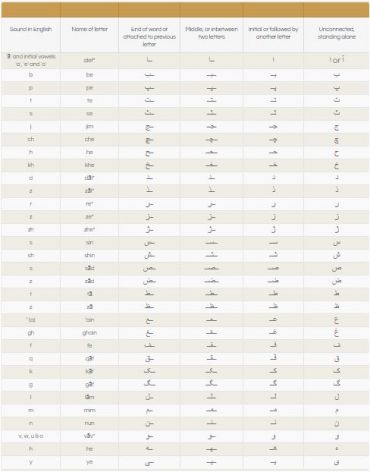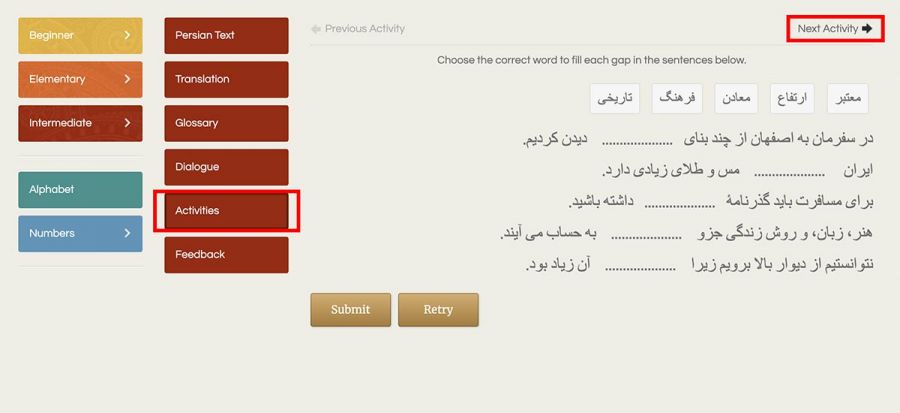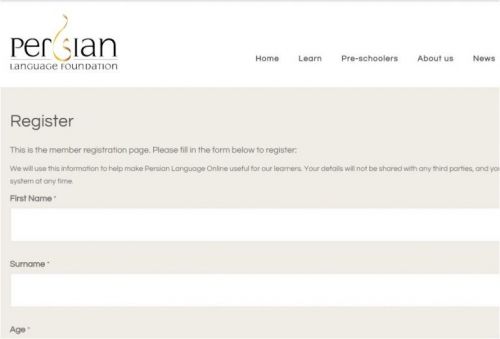
Project 6060 – Lesson 52
EN
FR
ES
FA
-
EN
Lesson 52
Persian Poetry and Prose
***
Translation
Persian literature is usually divided into the two main types of verse (poetry) and prose. Of course verse and poetry are slightly different, but we are going to overlook that here.
In poetry, the poet arranges his/her words in a special order to give them rhythm and rhyme, but in prose the writer brings discourse without rhythm and rhyme so that it is usually freer, more dispersed, and without a particular order.
Iranians also had poetry before Islam but since Islam much of this poetry has disappeared. Of the ancient pre-Islamic literature, only parts of the Avesta, the holy book of the Zoroastrians, has remained. After the victory of Islam in Iran, the Persian language, which was used for writing, fell out of use and Arabic was the dominant language for two centuries and no special literary works were written in Persian, but the (colloquial) form of the language; i.e. the ‘Dari’ form, was used informally amongst the people and became widespread in these two centuries. The spoken language gradually came under the influence of Arabic and the Arabic script came to be used for writing and, as a result, after this period, with a struggle by the Iranians, the Persian language spread in written form and, as a result, Persian literature found a new form. Actually, most of the literature of that time was in the form of poetry.
In various periods of history, poets and writers have sometimes had the protection of the king and sometimes, some of the kings would give orders to ruin libraries and burn books and writers and poets would either escape or be killed. These days, for example, only a few poetry lines, “beyts” exist from the first post-Islamic poets, even though many works of Iranian writers and poets in the further centuries post-Islam still remain, of which the most famous are the works of Ferdowsi, Khayyam, Nezami, Mowlavi, Sa’di, and Hafez.
In terms of form and structure, poetry can be divided into different categories including ballad, sonnet, masnavi, and quatrain. Every two hemistiches of a poem are called a ‘beyt’ and, as an example, quatrains have four hemistiches, i.e. two beyts, but sonnets have from 5 to 14 beyts, of which all have the same rhyme and rhythm, and the first hemistich of the poem has the same rhythm as all sonnets. The subject matter of poetry can also be romantic, mystical, epic, educational etcetera.
The method of expressing themes in poetry changes over time, but there exist similar characteristics in the works of some poets from various periods and it is possible for the poetry of somebody who lived a thousand years ago to have similarities with the character of the poetry of a poet who spoke a poem one hundred years ago.
In general, poets use similar styles and formats for composing poetry in each era, which can be more or less grouped according to subject, choice of words and difficulty of language. Although poetry can be classified on the basis of various viewpoints, the most common and normal categorisation of styles is on the basis of eras. From this perspective, the works of poets are categorised into four different styles. These four styles are:
- The Khorasani style, by which poets from the Khorasan region first spoke their poetry. It mainly takes the form of a ballad and its words and language are simple and clear, and there are few Arabic words in it. In this style, a poet mainly describes nature or tells of the victories of princes and kings.
- The Iraqi style, which mainly takes sonnet form and its language, despite being clear, is sometimes complex, containing similes and creative and flowing expressions. Most of the time, poems in the Iraqi style were used for expressing romantic, mystical, and moral themes.
- The Indian style, which they also call the Esfahani style, and which expresses romantic and humanitarian themes using fine and precise expressions and similes and combines language that is sometimes difficult and with spoken language.
- The Return style, in which era some of the poets let go of the Indian style and turned to the Khorasani style to compose ballads, and to the Iraqi style to compose sonnets.
Since the last century, there have been changes in the poetry of some poets because of the familiarisation of Iran with European poetry and world literature, as well as the start of the constitutional movement and revolution and social and political developments in Iran and a new style has appeared, which they call ‘new’ poetry. In new poetry, rhyme, rhythm and equivalence of beyts have little importance and because of this, it can’t be called ‘verse’.
Persian prose has also changed over time since Islam. At first, Persian prose was easy, clear, and without difficult Arabic words, but gradually, many Arabic words entered Persian writings and the willingness of some writers in complex writing, made Persian prose more and more difficult, but since about two hundred years ago, after hundreds of years, Persian prose regained its simplicity and simple writing gradually spread and journalistic prose appeared.
-
FR
Leçon 52
Poésie persane et prose
***
Traduction
Coming soon
-
ES
Lección 52
Poesía y prosa persa
***
Traducción
Coming soon
-
FA
درس پنجاه و دوم
شعر و نثر فارسی
***
متن فارسی
ادبیات فارسی معمولاً به دو گونۀ اصلی نظم (شعر) و نثر تقسیم می شود. البته نظم و شعر کمی فرق دارند امّا ما در اینجا آن را نادیده می گیریم.
در شعر، شاعر سخن خود را با نظم خاصّی آرایش می دهد که دارای وزن و قافیه است، امّا در نثر نویسنده سخنی را بدون وزن و قافیه می آورد که معمولاً آزادتر، پراکنده تر و بدون نظم خاصّی است.
ایرانیان پیش از اسلام نیز شعر داشته اند امّا بسیاری از این اشعار بعد از اسلام از بین رفته است. از ادبیات کهن پیش از اسلام تنها بخش هایی از اوستا، کتاب مقدّس زرتشتیان به جا مانده است. پس از پیروزی اسلام در ایران، زبان فارسی که برای نوشتن به کار می رفت کاربرد خود را از دست داد و به مدّت دو قرن زبان عربی زبان حاکم بود و اثر ادبی خاصّی به زبان فارسی نوشته نشد بلکه گونۀ محاوره ای آن زبان یعنی گونۀ دری به طور غیر رسمی در میان مردم عادّی به کار می رفت و در این دو قرن گسترش یافت. به تدریج زبان محاوره تحت تاثیر زبان عربی قرار گرفت و برای نوشتن از خط عربی استفاده شد و در نتیجه پس از این دوره با تلاش ایرانیان زبان فارسی برای نوشتن گسترش یافت و در نتیجه ادبیات فارسی شکل جدیدی پیدا کرد. البته بیشتر ادبیات آن زمان به صورت شعر بود.
در دوره های مختلف تاریخی گاهی شاعران و نویسندگان از حمایت پادشاه برخوردار بودند و گاهی بعضی از پادشاهان دستور خراب کردن کتابخانه ها و سوزاندن کتاب ها را می دادند و نویسندگان و شعرا یا فرار می کردند یا کشته می شدند. برای نمونه، امروزه تنها ابیات کمی از اوّلین شاعران بعد از اسلام وجود دارد، با این حال آثار زیادی از نویسندگان و شاعران ایرانی سده های بعد از اسلام هنوز باقی مانده است که مشهورترین آنها آثار فردوسی، خیّام، نظامی، مولوی، سعدی و حافظ هستند.
از نظر شکل و ساختار می توان شعر را به انواع مختلف از جمله قصیده، غزل، مثنوی و رباعی تقسیم کرد. هر دو مصراع شعر یک بیت نامیده می شود و برای مثال، رباعی چهار مصراع، یعنی دو بیت، دارد، امّا غزل دارای ۵ تا ۱۴ بیت است که همۀ آنها هم قافیه و هم وزن هستند و مصراع اوّل شعر هم قافیه با تمام بیت ها است. همچنین موضوعات شعر می تواند عاشقانه، عارفانه، حماسی، آموزشی و غیره باشد.
نحوۀ بیان مضامین در شعر با گذشت زمان تغییر می کند ولی در آثار بعضی از شاعران دوره های گوناگون ویژگی های مشترکی وجود دارد و ممکن است شعر کسی که در هزار سال پیش زندگی کرده است با شعر شاعری که صد سال پیش شعر گفته است خصوصیّات مشابه هم داشته باشند.
به طور کلّی در هر دوره ای بیشتر شاعران روش ها و سبک های مشابهی را برای سرودن شعر استفاده می کنند که کم و بیش از نظر موضوع، انتخاب کلمات و سختی زبان در یک گروه قرار می گیرند. اگرچه تقسیم بندی اشعار را می توان بر اساس دیدگاه های گوناگون انجام داد، امّا متداول ترین و معمول ترین طبقه بندی سبک ها بر اساس دوره هاست. از این نظر آثار شاعران را در چهار سبک مختلف طبقه بندی می کنند. این چهار سبک عبارتند از:
۱– سبک خراسانى که ابتدا شاعران منطقۀ خراسان به آن شیوه شعر می گفتند. شکل آن بیشتر به صورت قصیده و زبان و کلمات آن ساده، روان، و تعداد کلمات عربى در آن کم است. شاعر در این سبک بیشتر طبیعت را وصف می کند یا به بیان پیروزی های اميران و شاهان می پردازد.
۲– سبک عراقى که شکل آن بیشتر به صورت غزل است و زبان آن در عین روانى گاهی پیچیده و دارای تشبيهات و تعبيرات خلّاقانه و شيواست. اشعار سبک عراقی در بیشتر مواقع برای بیان مضامین عاشقانه، عرفانی و اخلاقی به کار رفته اند.
۳– سبك هندى که به آن سبک اصفهانی نیز می گویند و با تکیّه بر تعبيرات و تشبيهات ظريف و دقيق و ترکیباتِ زبانی گاهی دشوار با زبان محاوره ای به بیان مضامین عاشقانه و انسانی می پردازد.
۴– سبك بازگشت که در این دوره، برخی از شاعران سبک هندی را رها کردند و به سبک خراسانی برای سرودن قصیده و سبک عراقی برای سرودن غزل روی آوردند.
از یک قرن پیش، به دلیل آشنایی ایران با اشعار اروپایی و ادبیات جهان، همچنین با آغاز جنبش و انقلاب مشروطیّت و تحولّات اجتماعی و سیاسی در ایران، تغییراتی در شعر برخی از شاعران راه یافت و سبک جدیدی به وجود آمد که به آن شعر نو می گویند. در شعر نو وزن، قافیه و برابری بیت ها اهمیّت کمتری دارد و به همین دلیل دیگر نمی توان نام نظم به آن داد.
همچنین نثر فارسى بعد از اسلام در طول زمان تغییر کرد. ابتدا نثر فارسی آسان، روان و بدون کلمات سخت و دشوار عربی بود، امّا کم کم کلمات عربی بسیاری وارد نوشته های فارسی شد و تمایل برخی نویسندگان به پیچیده نویسی، نثر فارسی را دشوارتر و دشوارتر کرد، امّا از حدود دویست سال پیش بعد از صدها سال نثر فارسی به سادگی خود بازگشت و به تدریج ساده نویسی گسترش یافت و نثر روزنامه نویسی پدید آمد.
DIALOGUE
DIALOGUE
DIÁLOGO
مُکالِمه
-
EN
Translation of Dialogue
Maryam: What style of poetry do you like most?
Bahman: The Khorasani style.
Maryam: Why the Khorasani style?
Bahman: ‘Cause it’s easier and it has fewer Arabic words.
Maryam: Are you familiar with European literature too?
Bahman: Not much. What about you?
Maryam: I’ve read the works of some English writers and poets.
Bahman: In my opinion, European literature has had an effect on Iranian literature.
Maryam: That’s right, especially in story writing. -
FR
Traduction de Dialogue
Coming soon
-
ES
Traducción de Diálogo
Coming soon
-
FA
متن فارسی مُکالمه
مریم: کدوم سبک شعری رُ بیشتر دوست داری؟
بهمن: سبک خراسانی رُ.
مریم: چرا سبک خراسانی؟
بهمن: چون هم آسون تره و هم کلمات عربی کمتری داره.
مریم: با ادبیات اروپایی هم آشنا هستی؟
بهمن: نه زیاد. تو چی؟
مریم: آثار بعضی از نویسنده ها و شاعرای انگلیسی رُ خوندم.
بهمن: به نظرم ادبیات اروپایی رو ادبیات ایران تأثیر داشته.
مریم: درسته، مخصوصاً تو داستان نویسی.








